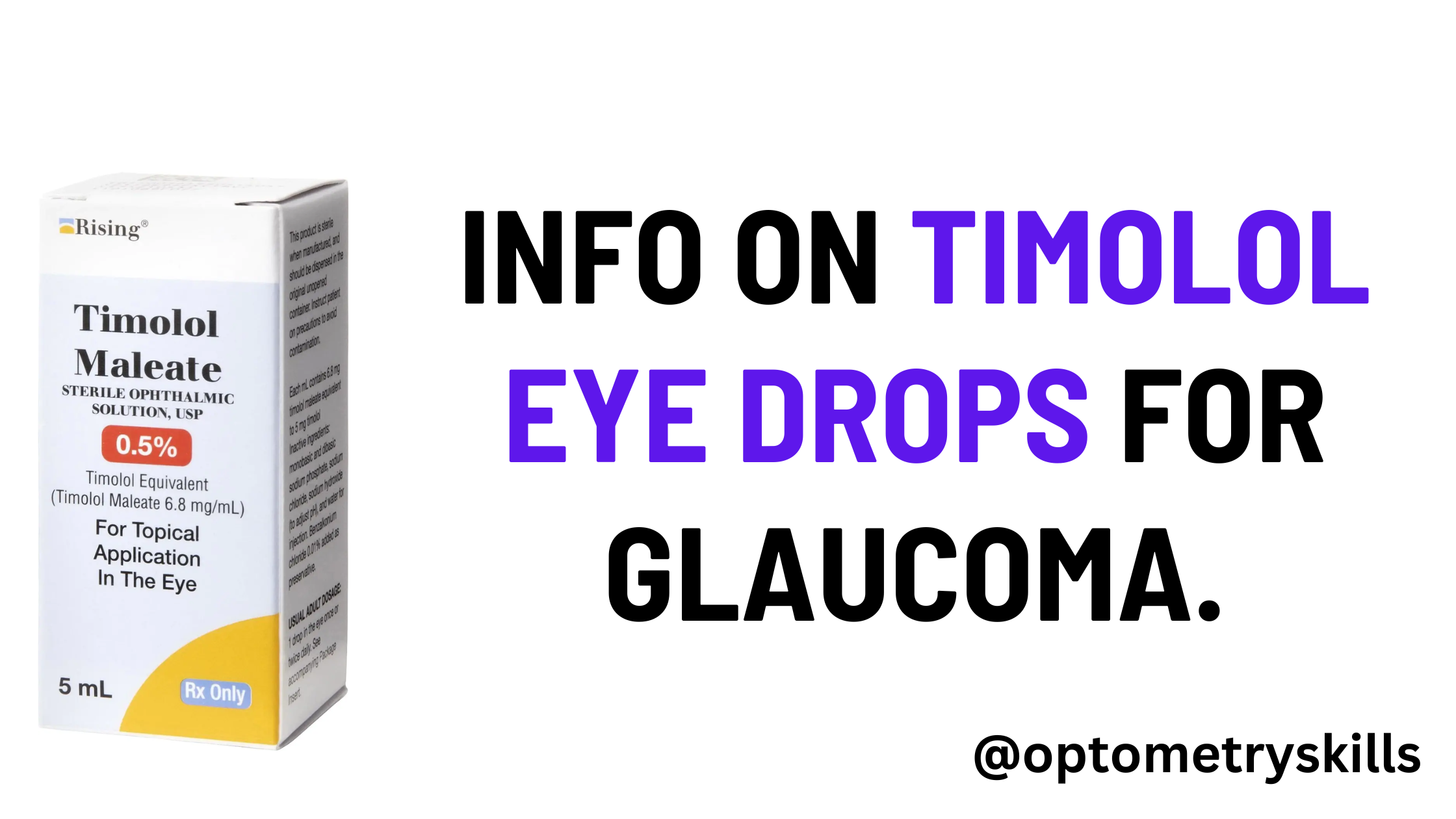Use of Timolol eye drops for glaucoma
What is timolol and how does it work?
Timolol eye drops are the eye drops used for Lowering high pressure inside the eye. Timolol eye drops are beta-blocker medication that reduces pressure inside the eye. It is used to treat increased pressure in the eye caused by open-angle glaucoma or ocular hypertension
Timolol Brands
Composition: timolol maleate
- Timoptic (Merck)
- Istalol (ISTA Pharmaceuticals)
- Timoptic-XE (Merck)
- Betimol (Bausch & Lomb)
- Timolol Maleate Ophthalmic Solution (Sandoz)
- Timolol GFS (Akorn)
Timolol can also be found in combination with other medications such as brimonidine (brand name Combigan) and dorzolamide (brand names Cosopt and Cosopt PF)

How is timolol used to treat glaucoma?
Timolol is used to treat open-angle glaucoma and other causes of high pressure inside the eye
The usual dose is 1 drop in the affected eye, once or twice a day .
Mechanism of Action:
Timolol is a non-selective beta-adrenergic receptor antagonist and reduces IOP by decreasing aqueous humor secretion. The beta-adrenergic receptors are found on the ciliary epithelium, which is responsible for the production of aqueous humor. By blocking these receptors, timolol decreases aqueous humor production, thereby reducing IOP. Additionally, timolol may also increase the uveoscleral outflow, which is another mechanism by which it reduces IOP.

Pharmacokinetics:
Timolol is administered topically in both gel and solution forms. After topical administration, timolol penetrates the cornea and reaches the aqueous humor, where it exerts its therapeutic effect. The bioavailability of timolol after topical administration is about 80-90%. Timolol has a peak concentration in the aqueous humor approximately 1-2 hours after administration, and its duration of action is around 12-24 hours.
Clinical Efficacy:
Numerous clinical studies have shown the effectiveness of timolol in reducing IOP in patients with glaucoma. In a randomized controlled trial involving patients with primary open-angle glaucoma, timolol reduced IOP by 25% on average. Another study comparing timolol to a prostaglandin analog found that timolol was similarly effective in reducing IOP. Additionally, the American Academy of Ophthalmology recommends using timolol as a first-line treatment for open-angle glaucoma.
Case study on Timolol eye drops for glaucoma
There have been several case studies and research conducted on the effectiveness of timolol eye drops for glaucoma. One such study was a randomized controlled trial conducted in Tanzania that compared the effectiveness of selective laser trabeculoplasty (SLT) versus 0.5% timolol eye drops for the treatment of glaucoma. The study found that SLT was superior to timolol eye drops for managing patients with open-angle high-pressure glaucoma for 1 year in Tanzania
Another case study reported enhanced intraocular pressure (IOP) control following appropriate management of ocular surface inflammation and a therapeutic switch to preservative-free tafluprost (0.0015%)/timolol (0.5%) fixed-dose combination therapy

What are the side effects of timolol?
The most common side effects of timolol are ocular irritation and burning, but these are generally mild and transient. However, systemic side effects are less common but may include bradycardia, hypotension, and bronchospasm. Timolol should be used with caution in patients with cardiovascular disease and asthma. Timolol may also interact with some medications, such as calcium channel blockers and beta-blockers.
Side effects may occur if this medicine is absorbed into your bloodstream .
Call your doctor right away if you have chest pain, trouble breathing, slow heartbeats, muscle weakness, numbness or coldness in your hands or feet, unusual mood or behavior changes, or severe dizziness .
Interaction with other drugs:
Some products that may interact with this drug include: oral beta-blockers (such as propranolol), clonidine, certain antidepressants (including SSRIs such as fluoxetine), digoxin, epinephrine, methyldopa, quinidine.
What are the warnings and precautions for using timolol?
- You should not use timolol ophthalmic if you have asthma or severe COPD, or a serious heart condition .
- Do not use timolol ophthalmic while wearing contact lenses. Timolol ophthalmic may contain a preservative that can discolor soft contact lenses .
Missed Dose
If you miss a dose, use it as soon as you remember. If it is near the time of the next dose, skip the missed dose. Use your next dose at the regular time. Do not double the dose to catch up.
How should timolol be used?
- Follow all directions on your prescription label and read all medication guides or instruction sheets .
- Wash your hands before using the eye drops. To apply the eye drops: Tilt your head back slightly and pull down your lower eyelid to create a small pocket.
- Hold the dropper above the eye with the tip down. Look up and away from the dropper and squeeze out a drop.
- Close your eyes for 2 or 3 minutes with your head tipped down, without blinking or squinting .
Reference:


